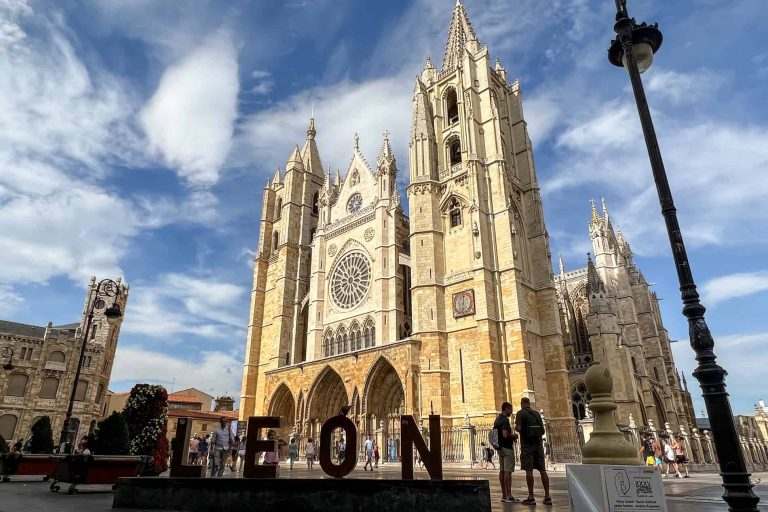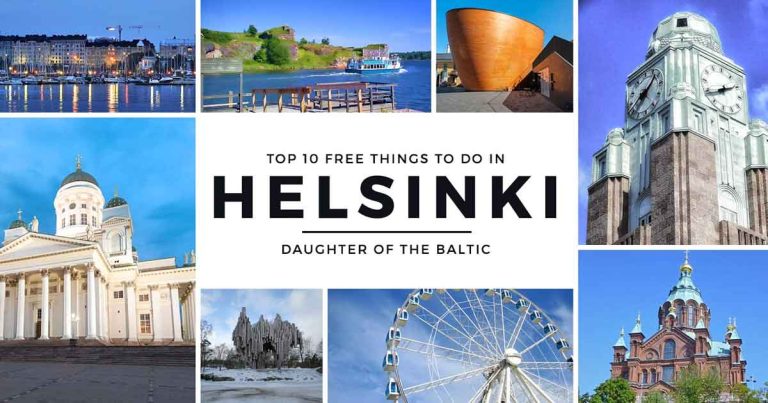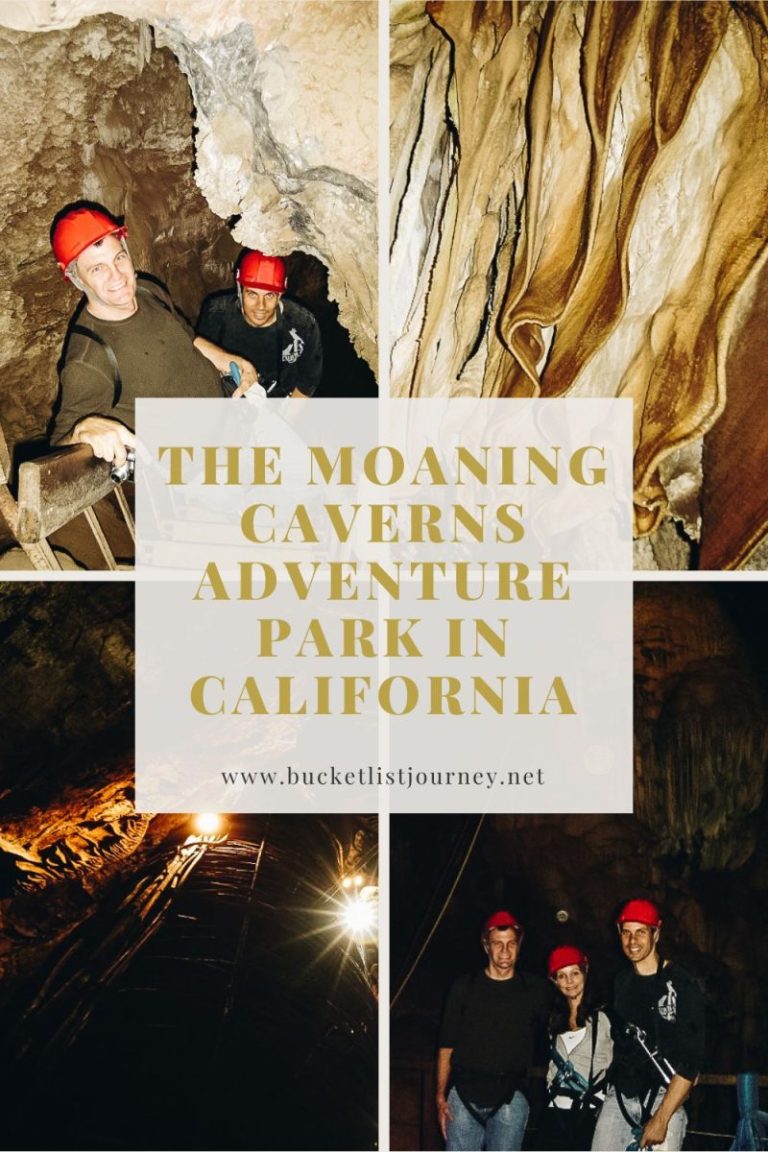Hiroshima Castle’s original structure from 1589, built by the Daimyo (feudal lord) Mori Terumoto, was destroyed by the atomic bomb in 1945. It was reconstructed in 1958 with its five-tiered main compound and surrounding defence system, a representation of a powerful seat of Japanese power during the Edo period.
Hiroshima Peace Memorial Museum.
The Park also contains important memorials such as the Children’s Peace Monument (in honour of Sadako Sasaki who was two when the bomb hit, and who died 10 years later from leukaemia caused by radiation exposure), the Korean Atomic Bomb Memorial (many Koreans were slave labourers in Japan during WWII), and the Flame of Peace (which will only be extinguished once the last nuclear weapon on earth has been destroyed).
“…But we must never forget that nuclear weapons are the fruits of war. Japan, too, with its colonization policies and resulting wars inflicted incalculable and irreversible harm on the peoples of many countries. A critical examination of not just the atomic bomb but also war and the causes of war is a prerequisite to learning the lessons of history.”
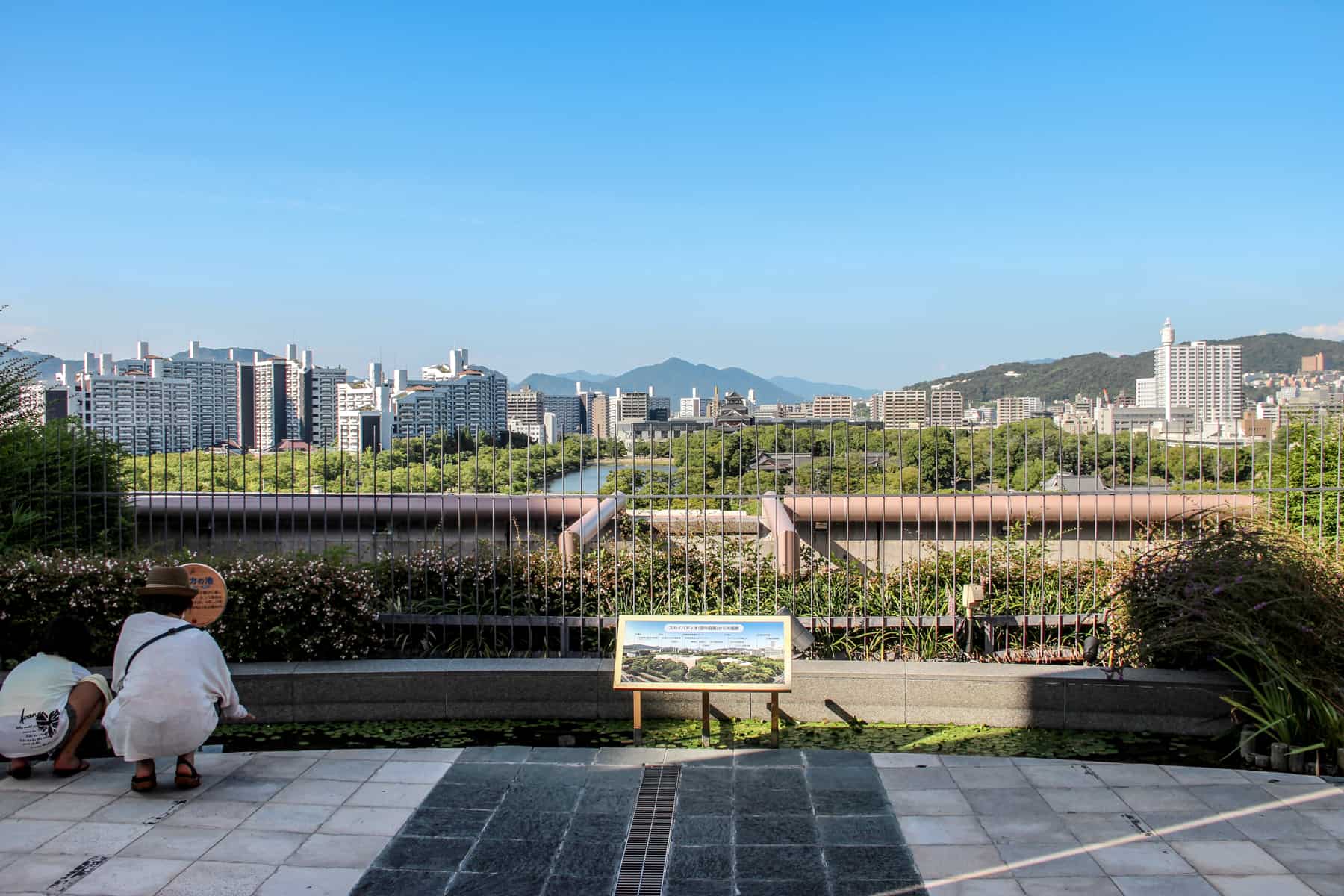
Hiroshima is a four-hour train ride from Tokyo (costing approximately £83/4) and one and half hours from Kyoto (£83/1) and should be considered as part of your Japan itinerary.
Remembering Hiroshima’s History
Disclaimer: This post contains affiliate links to handpicked partners, including tours, gear and booking sites. If you click through or buy something via one of them, I may receive a small commission. This is at no extra cost to you and allows this site to keep running.
The only thing that remains here from that time are ruins like the Atomic Bomb Domb – memorials to a period of history we must never forget. Today, Hiroshima is a city that calls on worldwide activism for peace.
The majority of your time will be spent in the Hiroshima Peace Memorial Museum. Graphic, touching and informative, the museum walks you through the history of the Pacific War and the lead up to the attack.
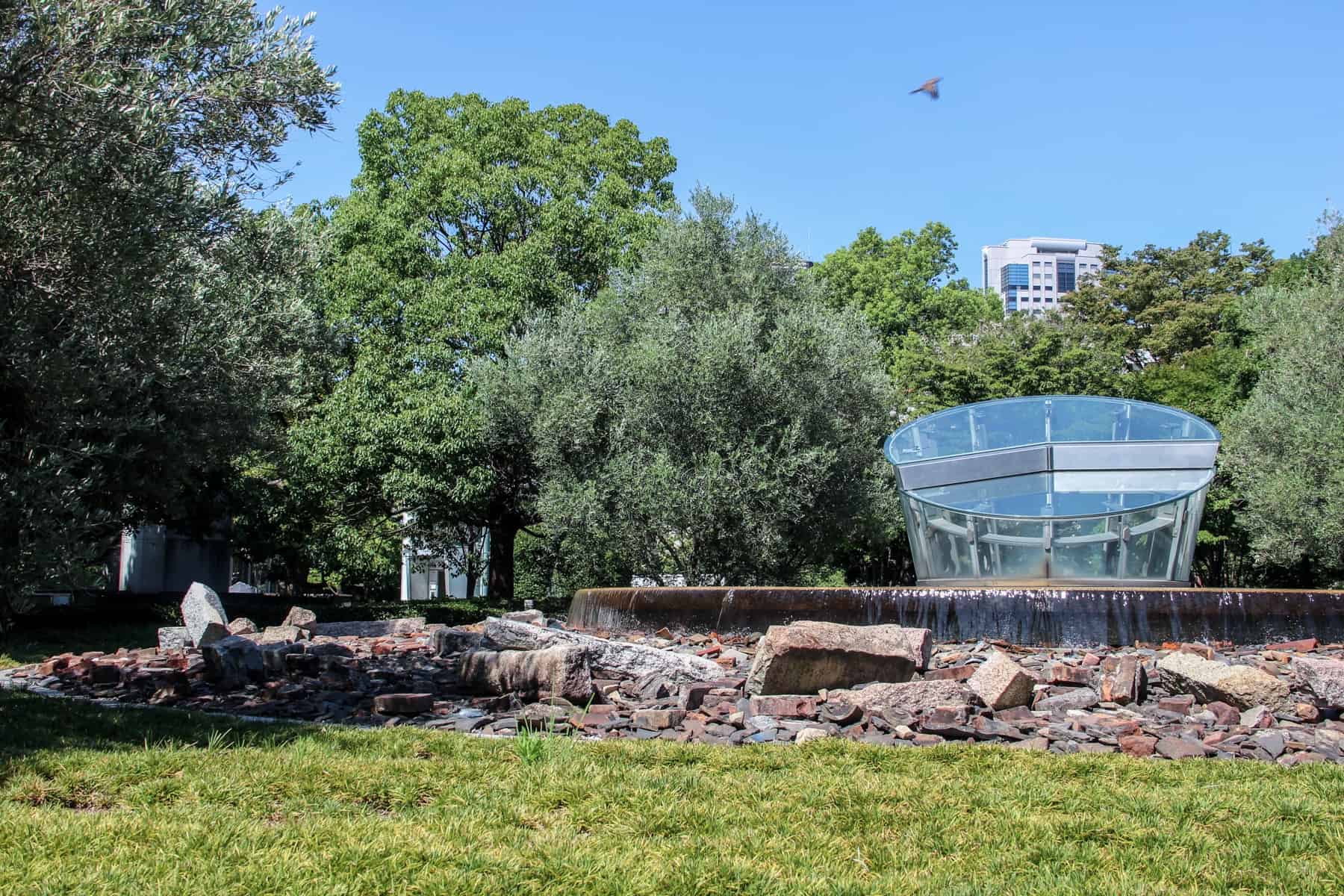
The former Bank of Japan building in Hiroshima.
Background to the War and the Use of the Atomic Bomb
We’ve all read about nuclear weapon development and heard of the threats to use it, but here, right before your eyes, is proof of the exact damage this kind of warfare produces. And then you start to think: if this is what it did to bricks and mortar, what did it do to human beings?
The Atomic Bomb Dome in the nature-filled Peace Memorial Park.
Hiroshima Calls for Nuclear Abolition
The first atomic bomb used against human beings exploded over Hiroshima and the world entered the nuclear age.
Hiroshima’s Flame of Peace will only be extinguished once the last nuclear weapon on earth has been destroyed.
When you travel to Hiroshima in Japan you will be surprised by its striking modernity and overwhelmed with emotion when you are confronted with its past. Many are shocked when they visit Hiroshima and see that it is a huge, functioning city, much the same in expanse and layout as many other key Japanese urban spots.
A clock in Hiroshima Peace Park shows the time 8:15 am, in reference to the atomic bomb dropped on August 6th 1945.
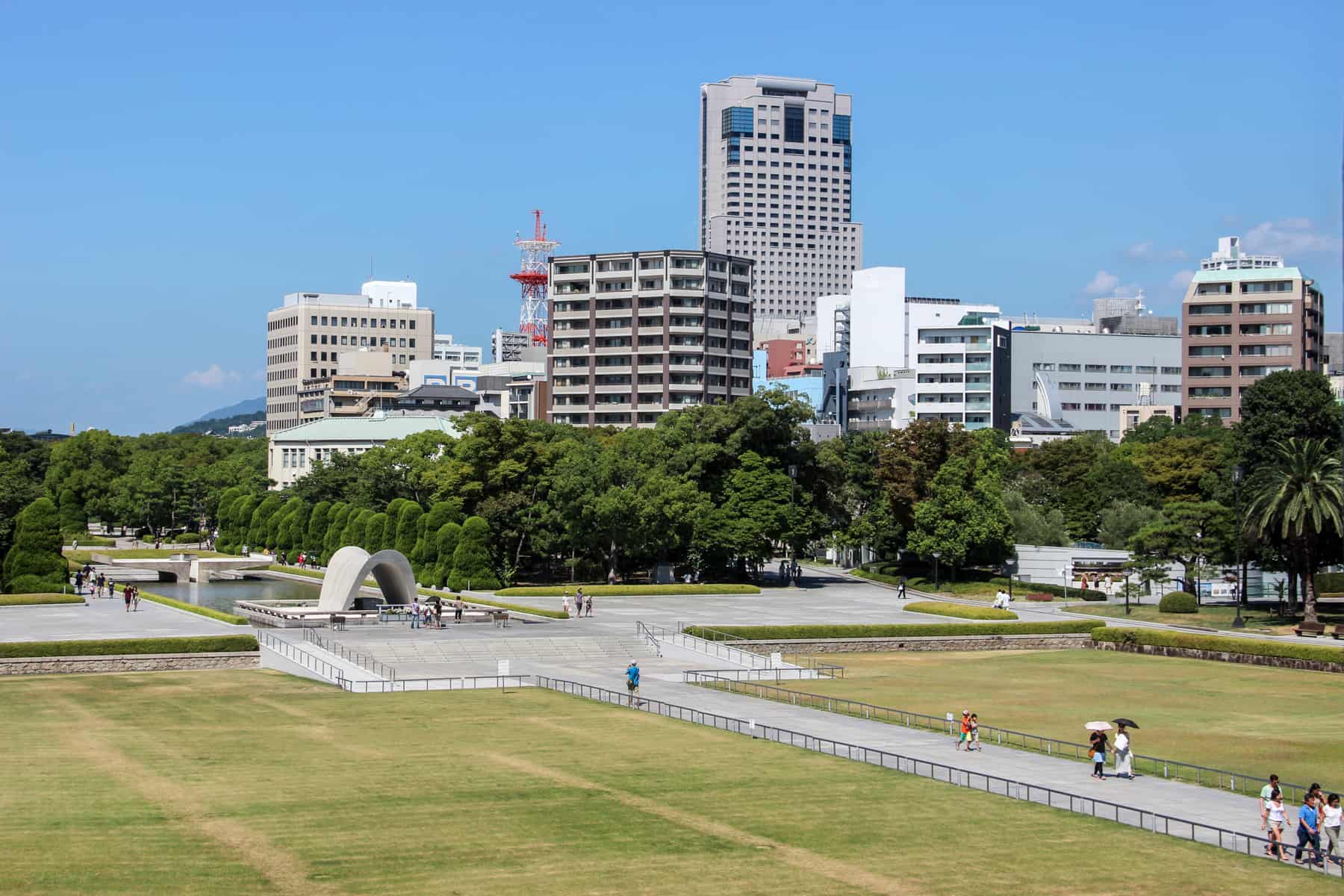
A few days after leaving Hiroshima, I met a local from the city who was working in Tokyo and told him I had visited and would be writing about it. He told me the story of how his grandparents survived as they lived far from the epicentre and said to me: “Please. Tell everyone about it. Everyone must visit. Everyone must learn.”
Is Hiroshima Safe to Visit Today?
What to Do in Hiroshima, Japan – The City With an Unforgettable History
The museum is not completely biased in its viewpoint and it was refreshing to see it used as a platform to highlight Japan’s faults during the war, stating:
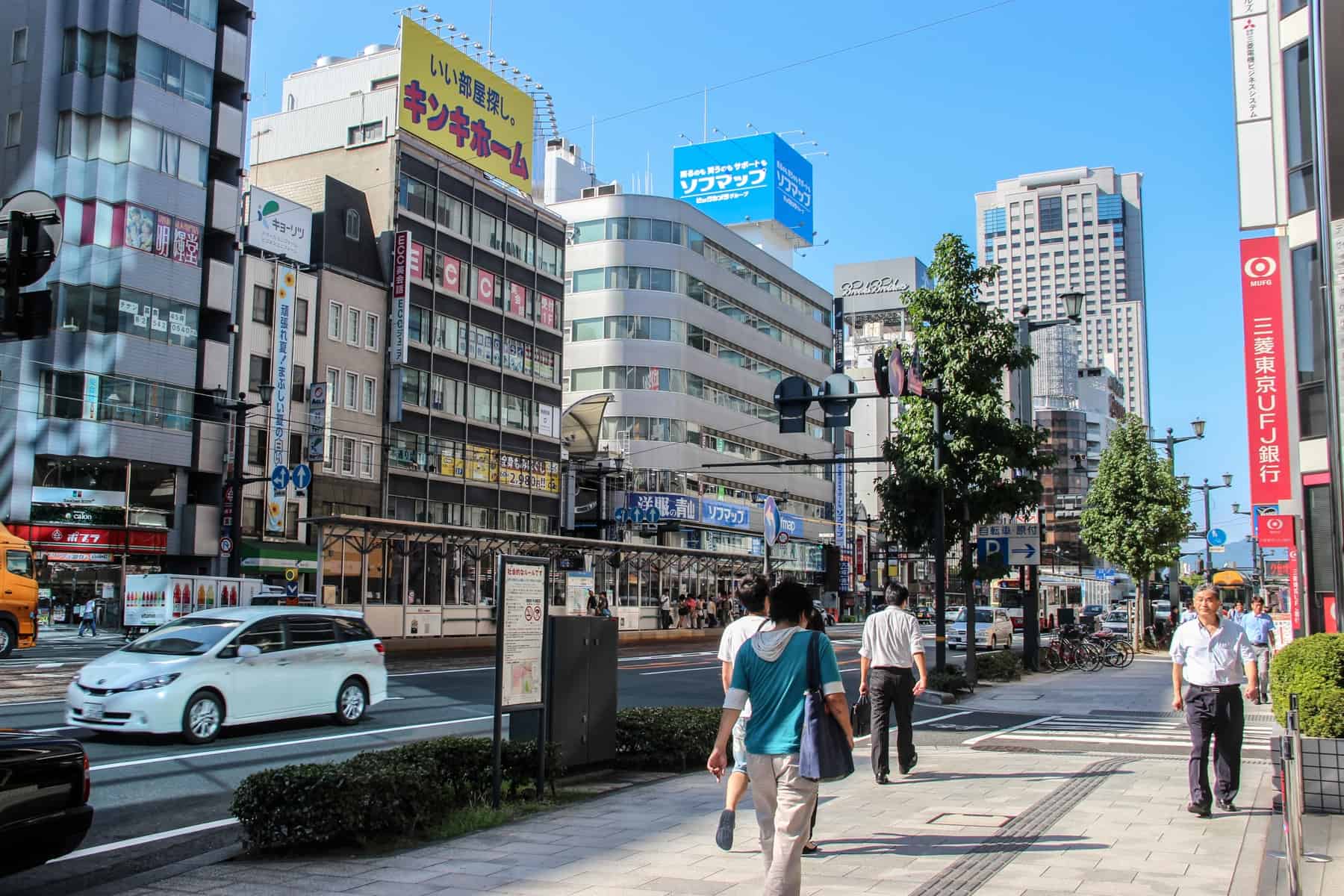
The A-Bomb Dome (what was once the Hiroshima Prefectural Industrial Promotion Hall) is the closest building to the epicentre (the exact location of the bomb’s detonation) left standing after the attack and is now the main memorial – a haunting image of the past overlooking the beautifully landscaped Hiroshima Peace Memorial Park site.
What to Do in Hiroshima Peace Memorial Park
See the Atomic Bomb Dome (A-Bomb Dome)
Visit Hiroshima Castle and Shukkei-en Garden in the middle of the city.
I’ve always seen images of the Atomic Bomb Dome – the most iconic symbol of Hiroshima – but when I finally saw it I felt struck down by emotion and must have stood there staring at it the exposed steel and skeleton foundations from all angles for at least half an hour. I wasn’t expecting to feel so overwhelmed.
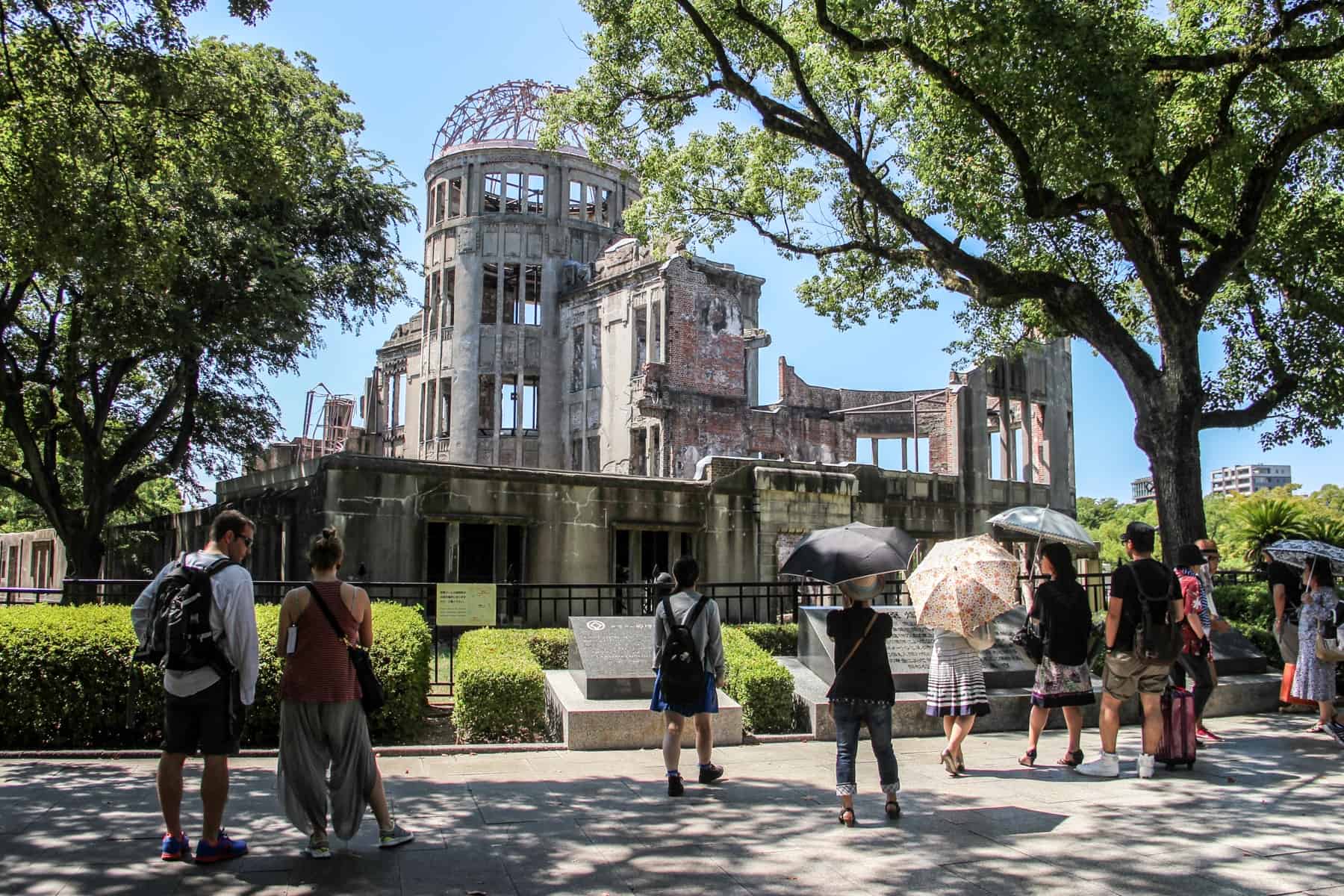
Reminders of Hiroshima’s history sit alongside the modern city.
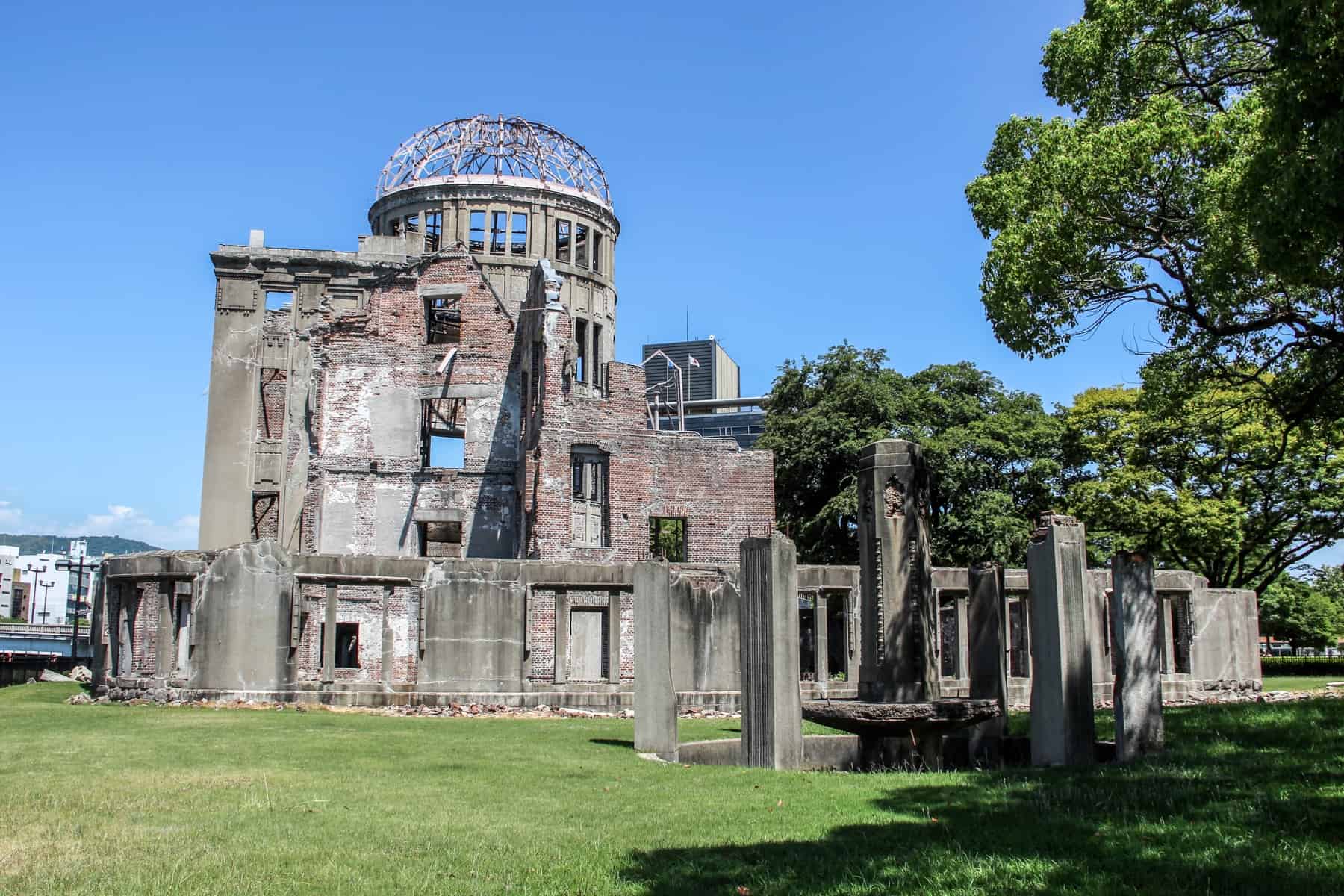
People in Hiroshima today still campaign for change.
Yet, it does call for one thing: the abolition of nuclear weapons, globally, and for a peaceful international community. With Hiroshima being given the title as a ‘City of Peace’ in 1949 when the Peace Memorial Park was built, it has since been on the international stage for holding conferences on peace and global social issues and in 1998 the Hiroshima Peace Institute was established to continue to raise awareness. Successive Mayors of Hiroshima have sent letters of protest in response to every nuclear test by any country since 1968.
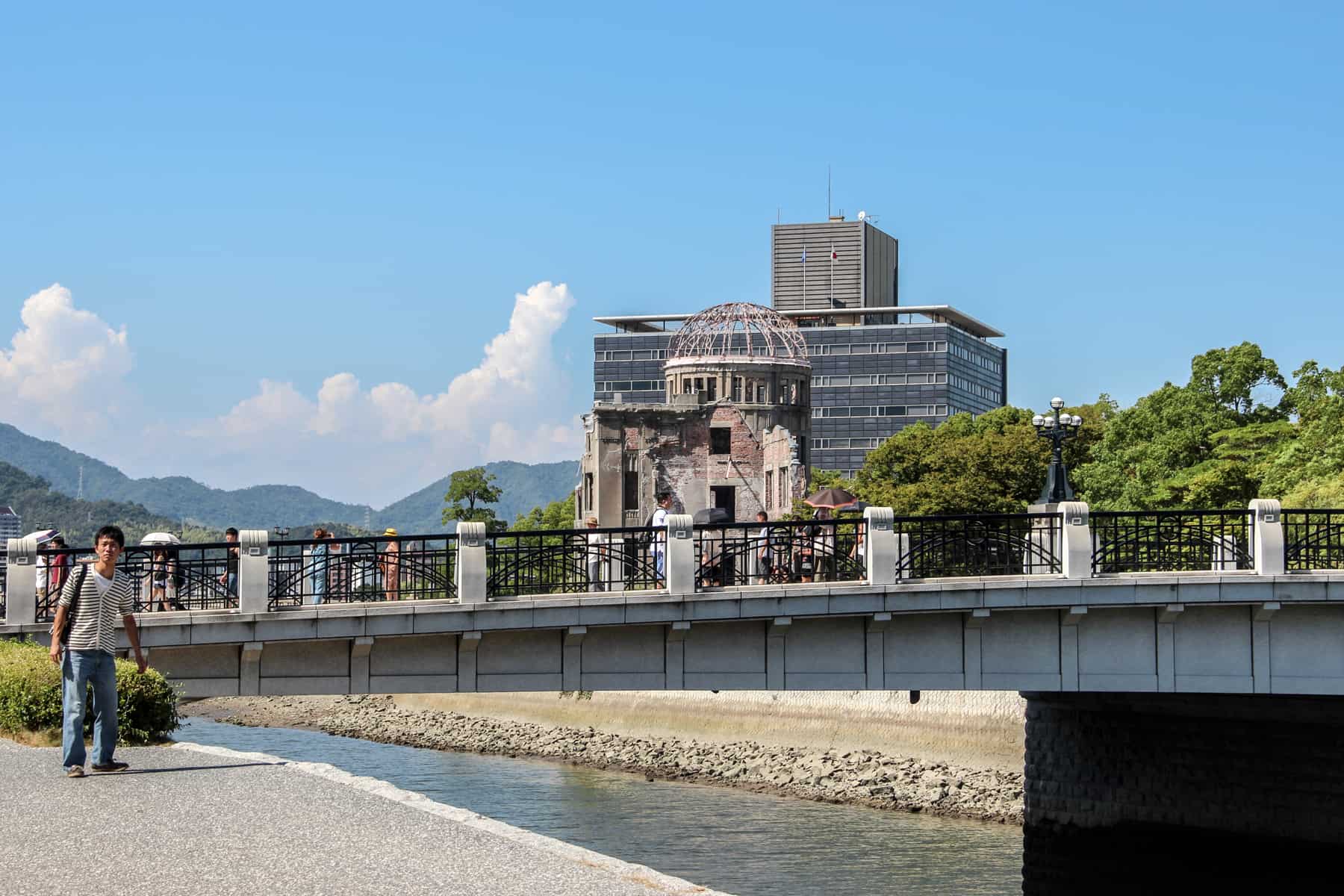
Related
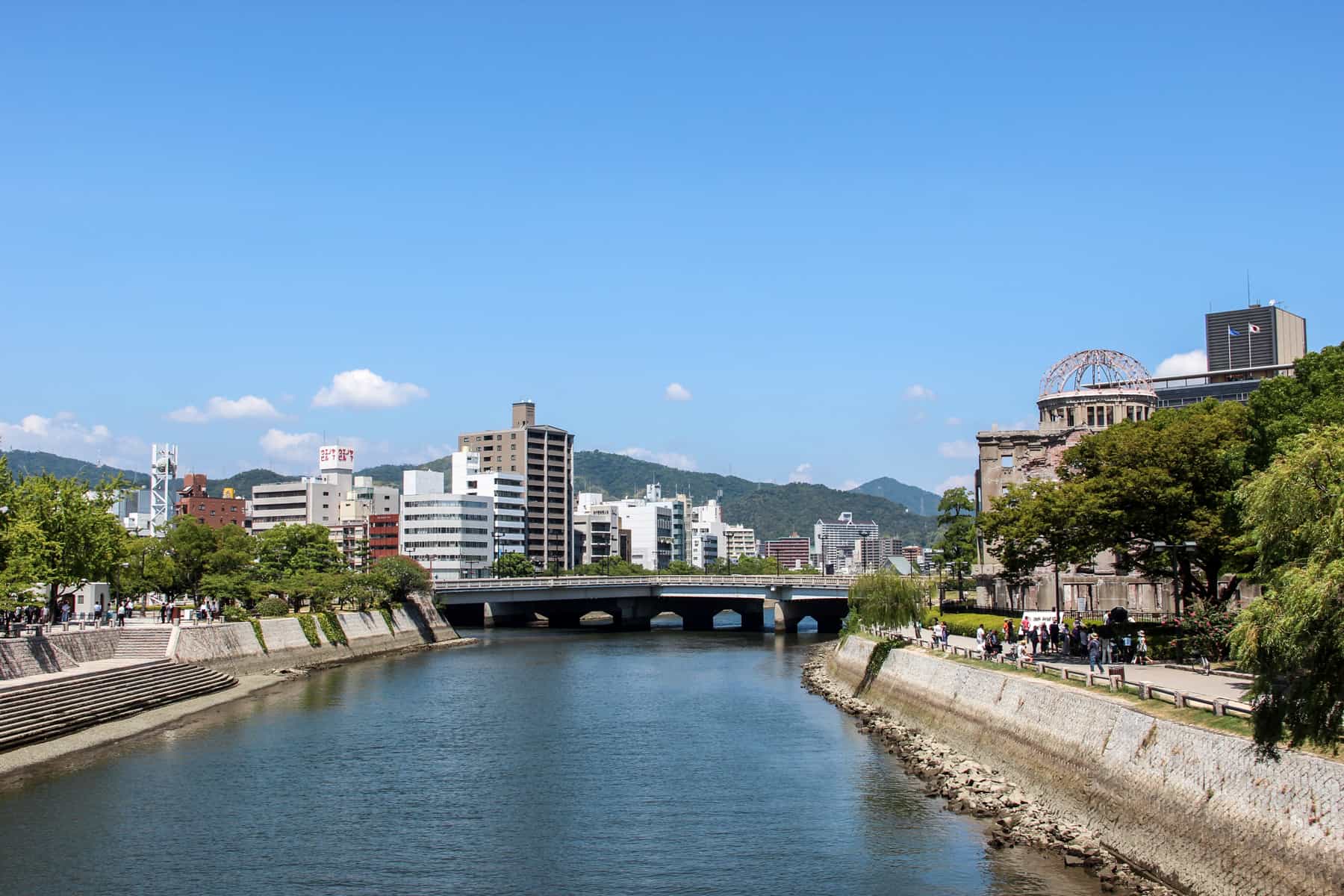
READ ALL: On my Destination Page for Japan.
Hiroshima’s Peace Memorial Park is filled with sculptures and monuments.
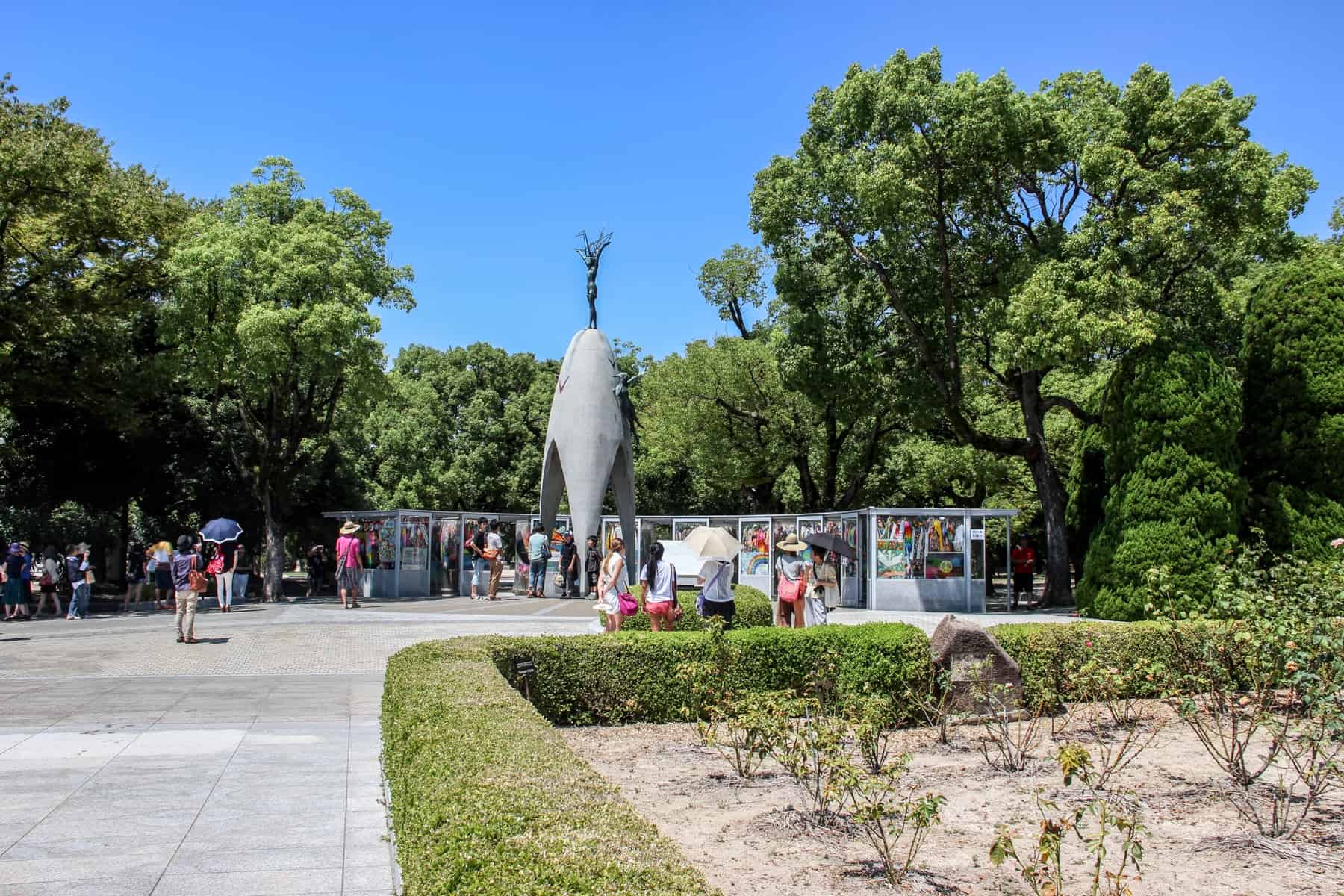

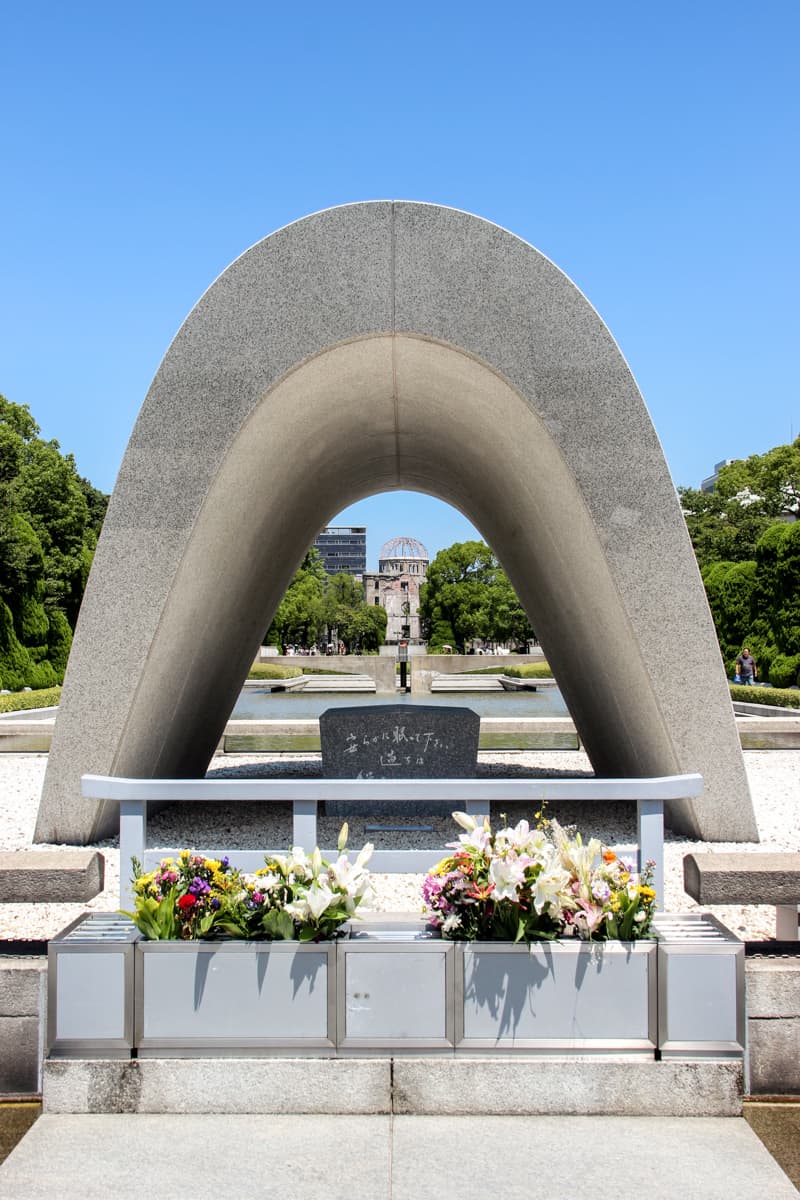
Like any other Japanese city, Hiroshima teems with urban life – business, eateries, cafes and art spaces. I choose to wander without any particular plan, crossing bustling shopping streets and squares with art sculptures.

Near to the end of my time in the museum, I stood in line behind a Japanese man, his wife and their two children. He wouldn’t stop crying every time he saw another image of a burnt person, charred clothing and objects that had melted or changed in shape and texture instantly from the intense blast of heat. Only then did I realise how this event is still affecting the Japanese people today.
Meet and Learn from the Peace Activists
The Hiroshima Peace Park Memorial wedged between the modern city skyline.
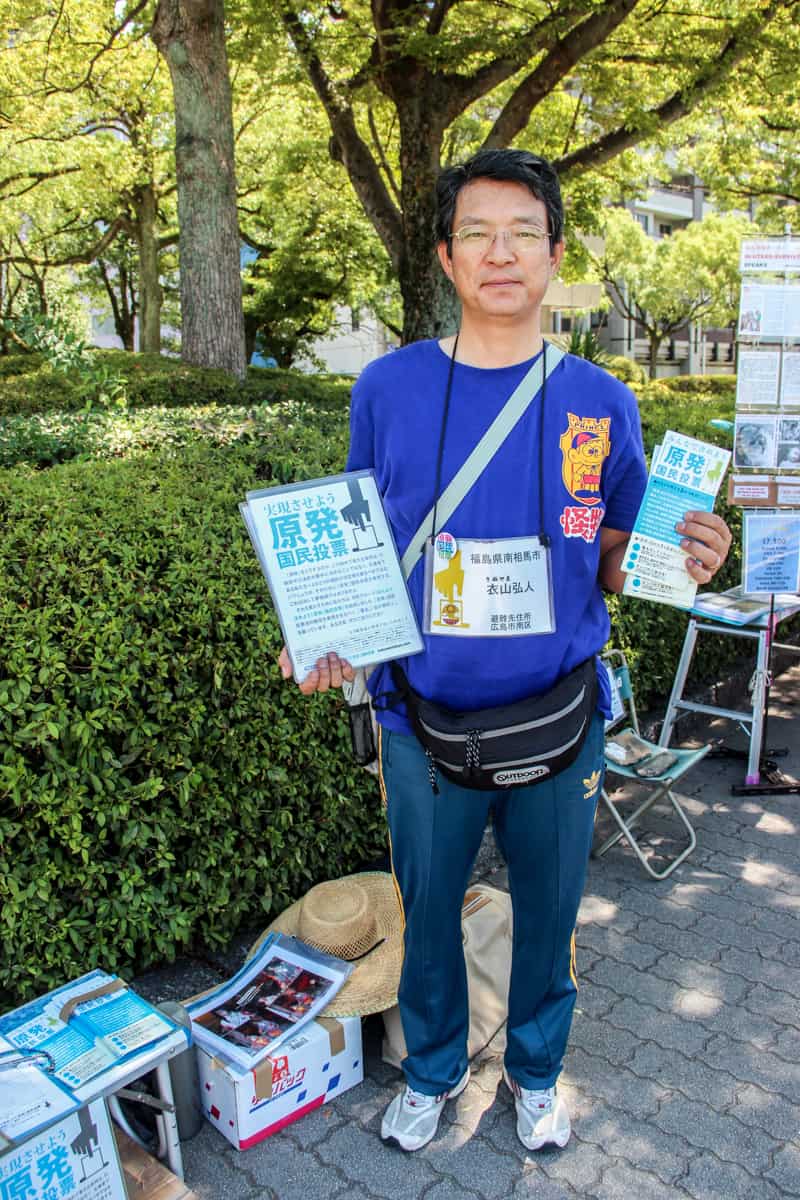
Visiting the Peace Memorial Park.

The city is more known as being the first city in history to be targeted and destroyed by a nuclear weapon – an atomic bomb which was dropped by the United States Army Air Forces during the final stages of World War II, killing thousands of people within seconds.
The Hiroshima Peace Memorial Museum
And to him, I dedicate this post, remembering how we shook hands and smiled as newfound friends, as I promised to be one voice. One voice of many, spreading the courage of the people of Hiroshima, who have risen from the ashes and who now fight for peace.
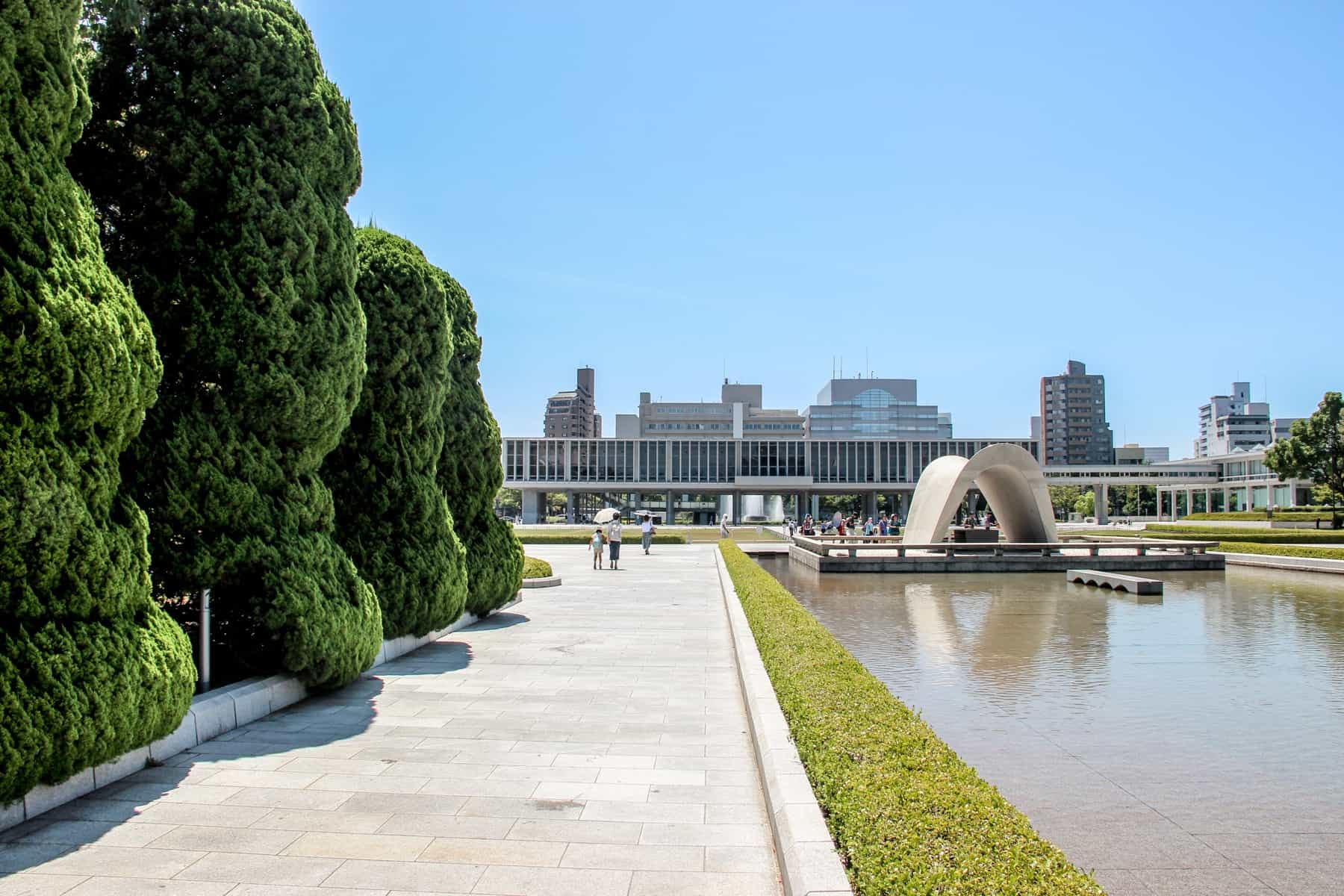
The feudal fortress sits in the very centre of the city, rather than elevated in the hills, and with its construction came the essence of Hiroshima – today’s urban metropolis grew from its original existence as a castle town.

Hiroshima Peace Poster Exhibition.
If you are planning a trip to Japan that includes Hiroshima and don’t know where to start, check out some of my other Japan travel tips and city overviews for inspiration.
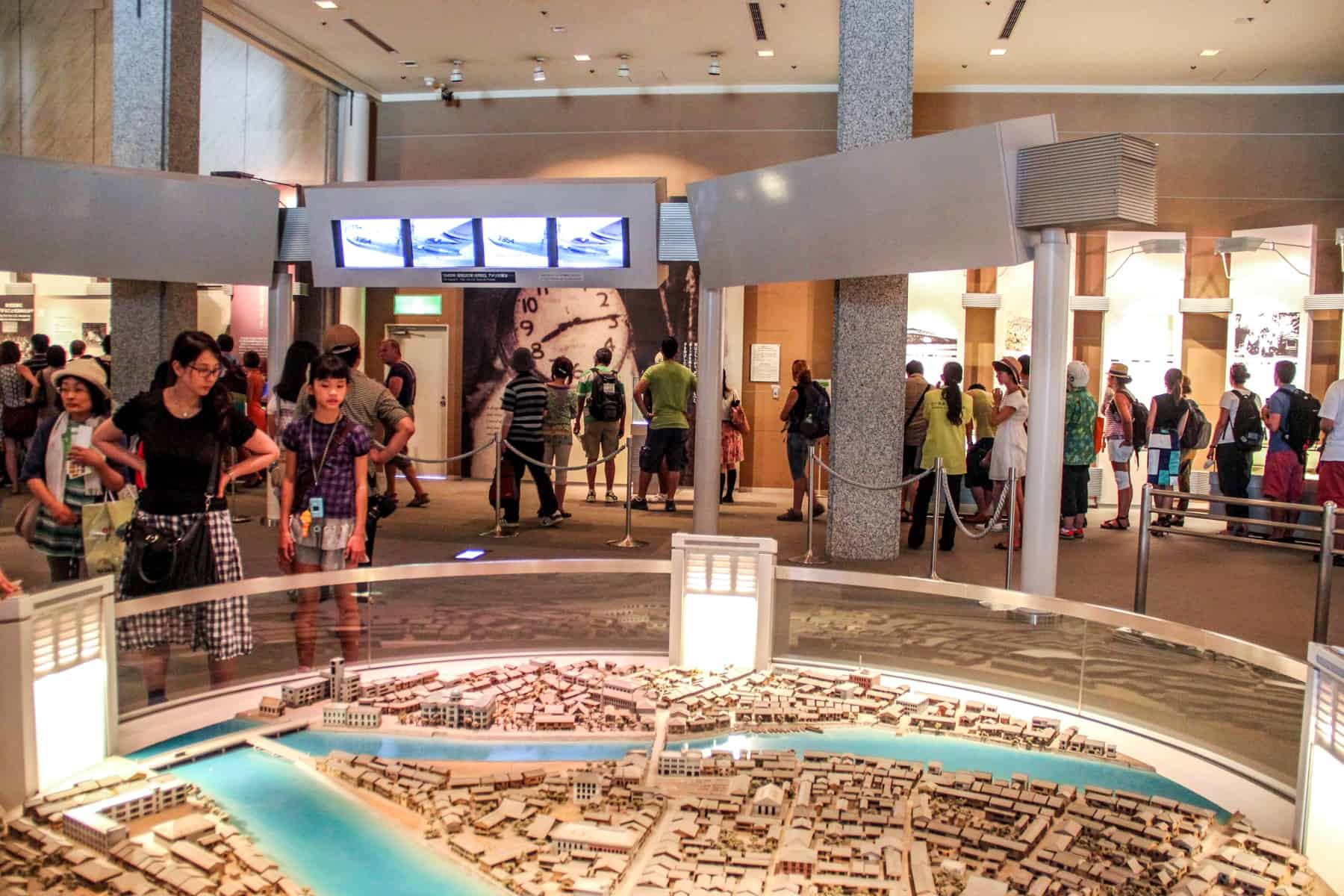
Many people ask: Is Hiroshima radioactive today? While many visitors assume that Hiroshima is still partially derelict from that time, it’s far from that image. It’s not a nuclear wasteland but a modern, functioning city of green spaces, vibrant urban centres art and compact islands.
Playing cards sculpture and public seating area in Hiroshima’s urban centre.
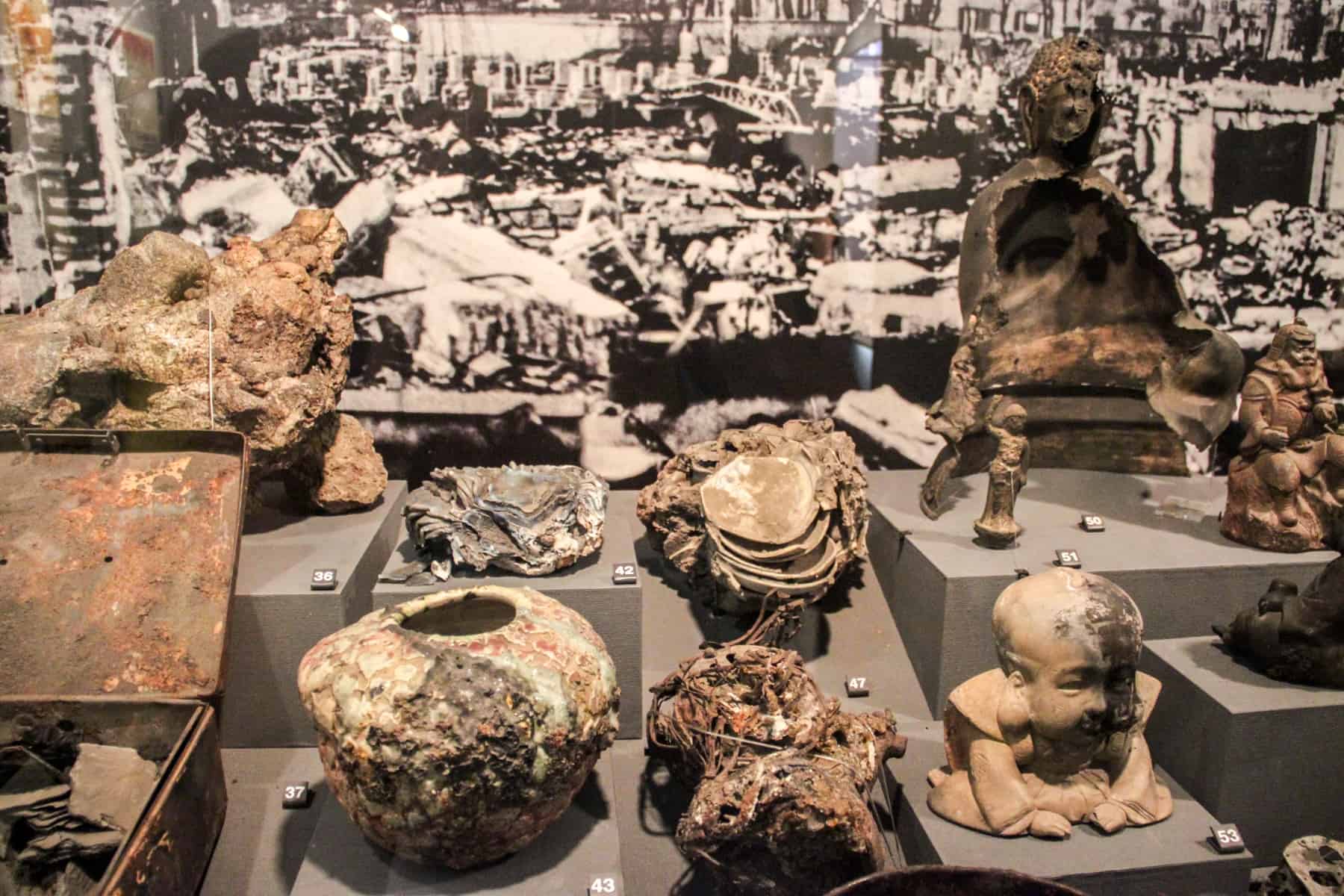
The nature of the bombing and the roles and agendas of the US and the Japanese during the Pacific War are still very much debatable.
£15, for a dorm room.
Many think visiting Hiroshima is to see a radioactive wasteland, but it’s far from it. Here’s the things to do in Hiroshima – a thriving modern metropolis that doesn’t forget its history as the first city in the world destroyed by a nuclear bomb.
One of Hiroshima’s artistic public spaces.
The Hiroshima Peace Memorial Museum at the end of the Peace Park.
The heat rays exceeded a million degrees Celsius at the point of detonation and the blast destroyed everything within a two-kilometre radius. It is said to have instantly killed an estimated 80,000 people – around 30% of the population of Hiroshima – and a similar number were injured. Casualties from injury and radiation reached thousands upon thousands by the end of that year, with survivors suffering irreparable physical and psychological damage, still visible today.
The bombing of Hiroshima, as well as nearby Nagasaki, are the only direct uses of the atomic bomb to date and when wandering the city’s streets, arty hang-out spaces and leisurely perusing the Hondōri shopping arcade, you would have no idea that approximately 70% of Hiroshima city was once completely wiped out in one of history’s biggest atrocities.
Things to Do in Hiroshima City
Visit the Hiroshima Peace Poster Exhibition
A shopping street in Hiroshima city with hanging peace artworks made by the city’s children.
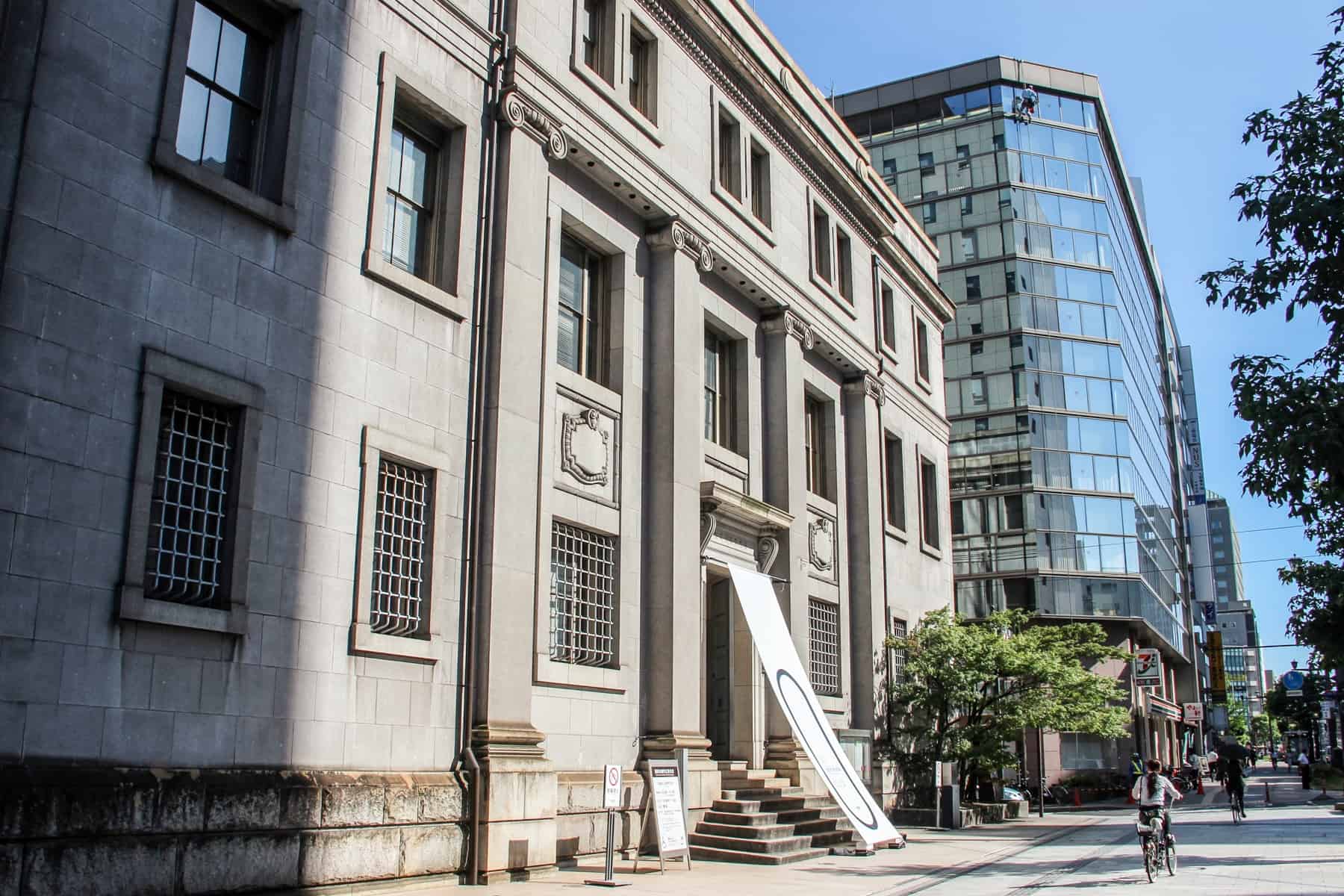
8:15 am, August 6th 1945
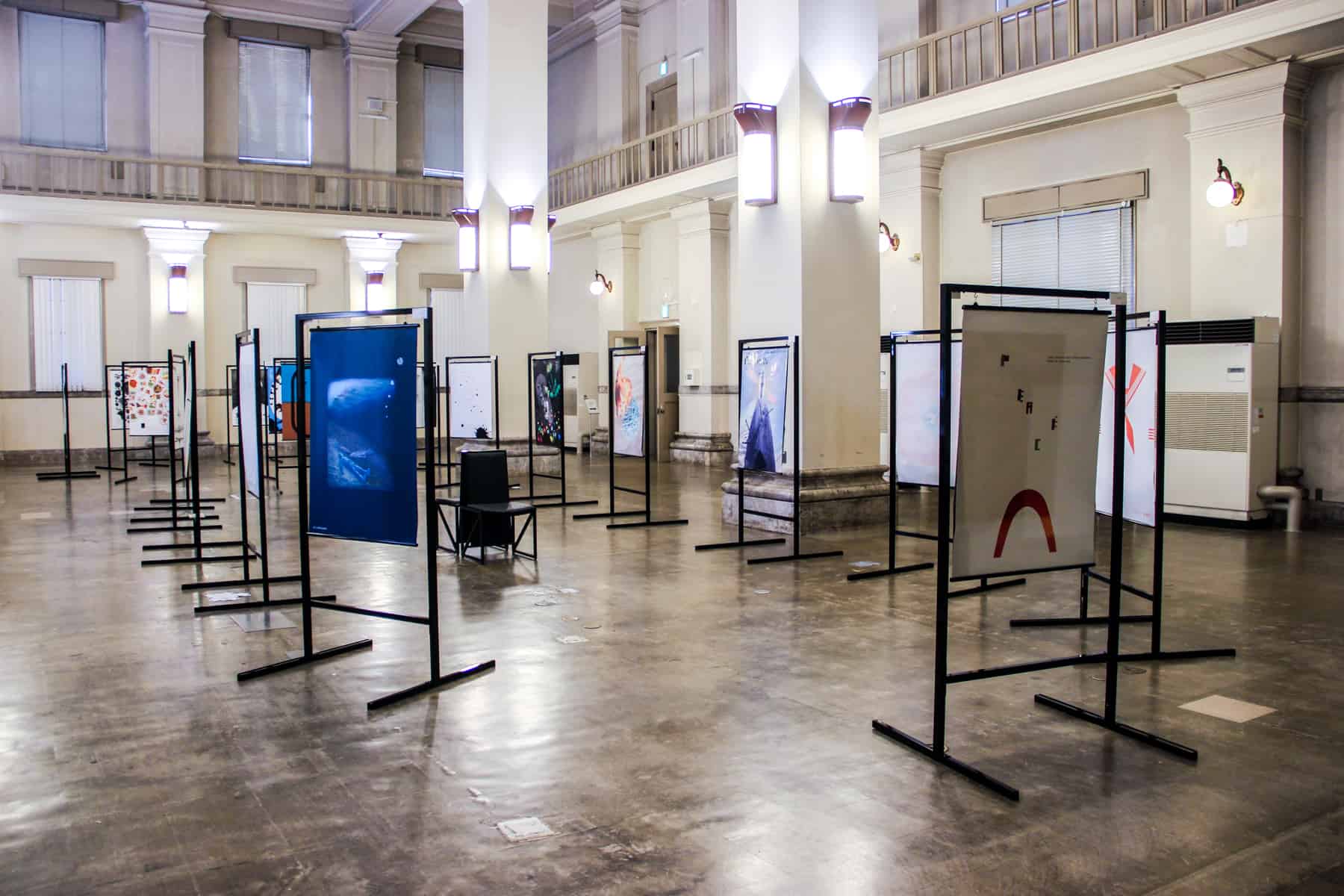
You can even watch Baseball here at the Mazda Zoom-Zoom Stadium. The Hiroshima Toyo Carp are Hiroshima city’s professional baseball team.
Hiroshima Castle and Shukkei-en Garden
Whilst Japan was given warnings about intense air raids if it didn’t surrender, it was not given a warning about the use of an atomic weapon. Japan’s bomber watch system was tricked when a US plane flew over Hiroshima in the direction of west to east. It was thought that this plane was checking the weather and that a bomber plane would follow it from the same direction. Except for the American B-29 bomber – the ‘Enola Gay’ carrying the atomic bomb “Little boy” – came from the east and exploded 600m above the ground, intended to cause the most devastation with a violent blast.
Japan was ruling the Korean peninsula, Taiwan and northeastern China – opposing it, the US and other countries took severe economic sanctions against Japan – whilst much of Southeast Asia was controlled by western forces. Japan insisted that its aim was to release these countries from Western control when really they were desperate for the natural resources in these areas.
The US was considering ending the war by either invading the Japanese mainland, asking the Soviet Union to join the war, ensuring the continuation of the Japanese Emperor system or using the atomic bomb – the latter of which would also ensure that Soviet influence in Japan would be restricted. Hiroshima is said to have been chosen as a target because it didn’t have an Allied prisoner-of-war camp.
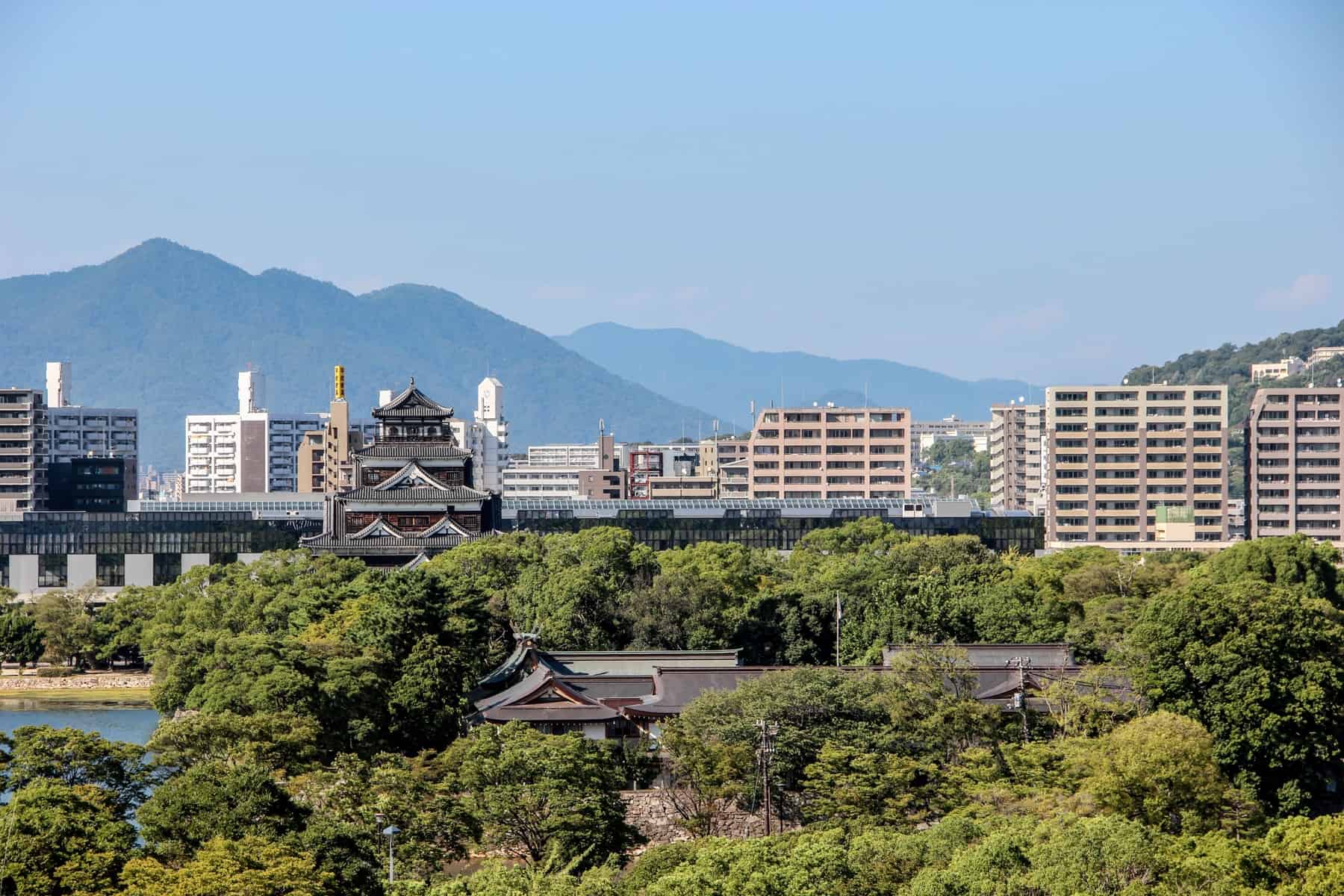
I met two Japanese men near the Peace Memorial Park. One, who had no choice but to move away from his home near the Fukushima nuclear plant, now runs a petition demanding a national referendum for the maintenance of or abolition of nuclear power generation. The other man’s mother was four months pregnant with him at the time of the attack and he was born, luckily, without any major health issues. He gives detailed, historical guided tours around the park. Both work in the area every day, raising awareness and calling for change.
Wander Hiroshima’s Urban Centre
Learn from peace activists and survivors in Hiroshima.
It displays belongings left by victims and other materials conveying the devastation, educates about the development of nuclear bombs and how they work, talks about the long-term effects of radiation exposure including what is done to support the survivors today (called ‘Hibakusha’ – many of whom are tormented by discrimination and prejudice) and highlights Hiroshima’s role on the world stage as leaders of the peace movement.

The Children’s Peace Monument.
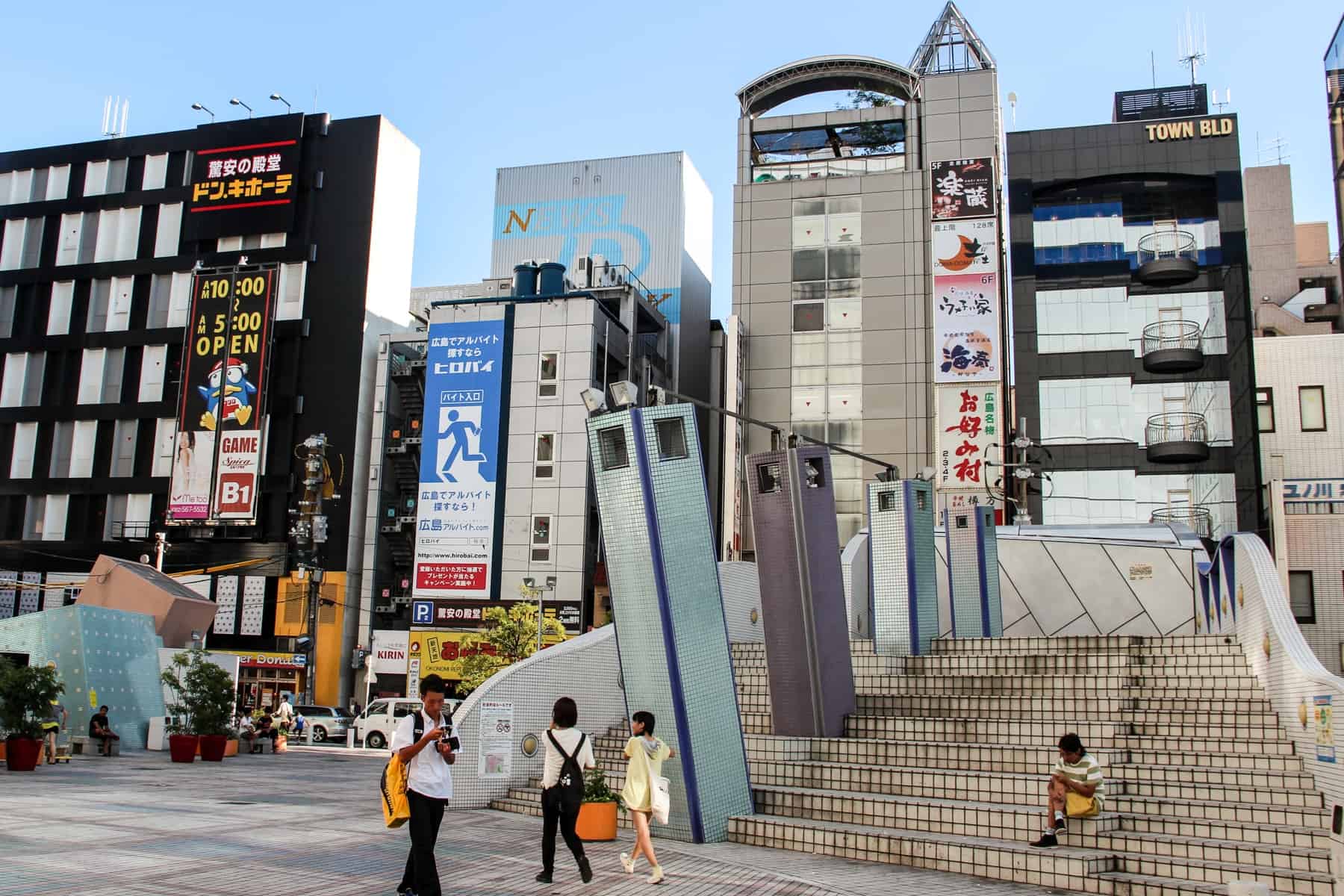
Charred, burnt and melted objects on display at the Hiroshima Peace Memorial Museum.
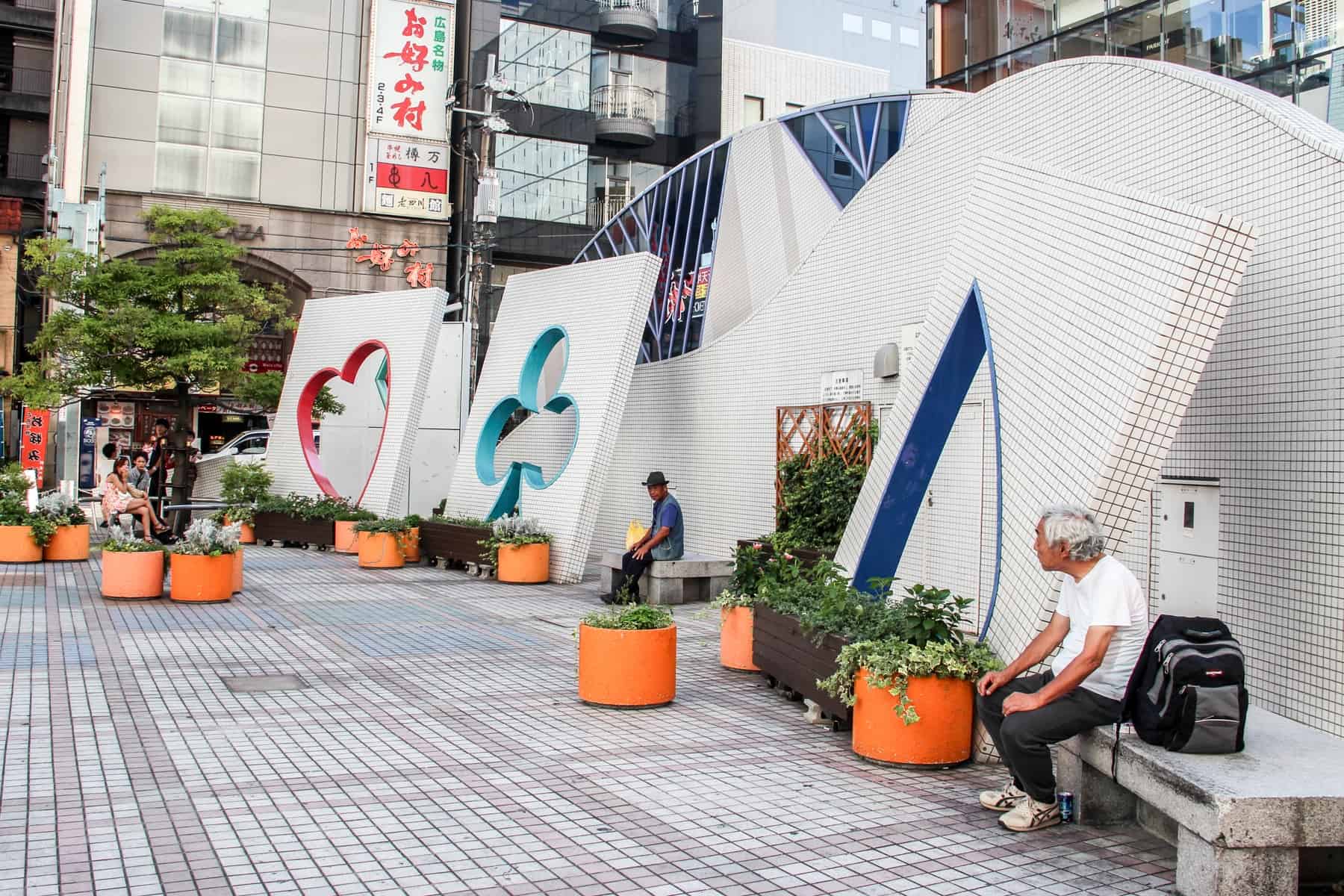
Many more ask: is the use of the atomic bomb unethical and unjustified in forcing a country to surrender and does the use of the atomic bomb constitute a war crime? The debates continue and you may find it’s one of many you have with your fellow hostel friends when you return.
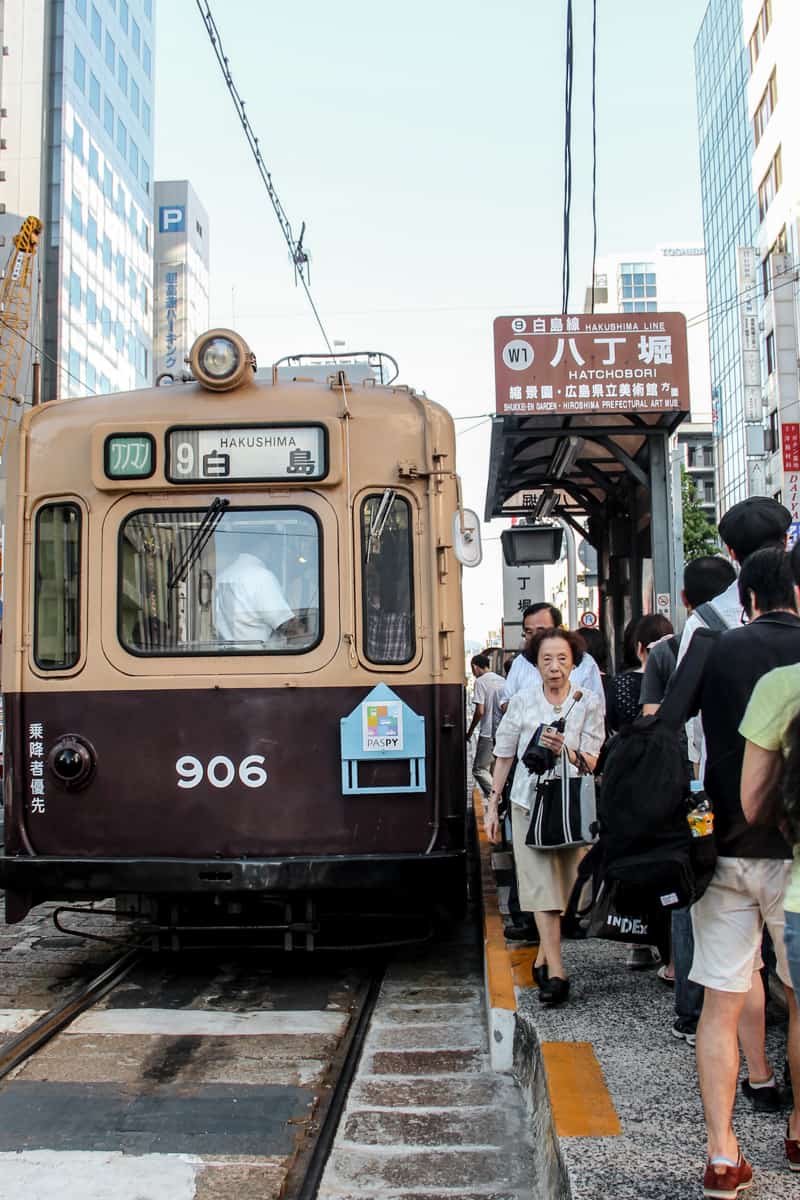
Hiroshima today – a thriving, modern city.
Learning from Hiroshima
As the Hiroshima Peace declaration of 2013 highlights: “The city of Hiroshima and the more than 5,7000 cities that comprise Mayors for Peace, in collaboration with the UN and like-minded NGO’s, seek to abolish nuclear weapons by 2020 and throw our full weight behind the early achievement of a nuclear weapons convention.”
Some say it was justified that the US retaliated after the Japanese made the first strike with the attack on Pearl Harbour; others say the US is said to have potentially provoked Japan to attack them so that they had an excuse to use force and push out the Soviet forces who were gaining control in Japan.
Things to Know About Visiting Hiroshima
Peace Memorial Park
-
- Entry to the Peace Memorial Park is free.
- Entry to the Peace Memorial Museum costs 50 Yen (50 cents).
How to Get to Hiroshima
Learning about the layout of Hiroshima and the devastation of the atomic bomb impact.
While in Hiroshima, be sure to check out the former Bank of Japan building – another structure still standing after the blast and which has been restored and turned into the Peace Poster Exhibition and art gallery – before resting in one of the many coffee shops or bars around the city.
Where to Stay in Hiroshima
Many people are put off by the high cost of the rail ticket and so it might be worthwhile investing in a JR Rail Pass (7 days: £178 / 2 14 days: £285 / 9 21 days: £364 / 5 $) to make the cost worthwhile. Visiting the A-Bomb Dome – the iconic symbol of Hiroshima.
Travelling to Japan
Japan’s most famous torii gate and UNESCO World Heritage Site is located in Miyajima – another sightseeing cultural highlight of the region. You can get up close to it when the tide is low, and marvel at its floating on water illusion when the tide is high.
